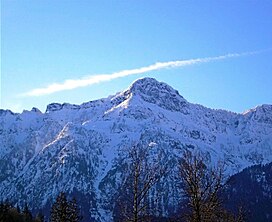| Mount Persis | |
|---|---|
 Northeast aspect Northeast aspect | |
| Highest point | |
| Elevation | 5,464 ft (1,665 m) |
| Prominence | 544 ft (170 m) |
| Parent peak | Mount Index (5,991 ft) |
| Isolation | 1.59 mi (2.56 km) |
| Coordinates | 47°47.26′N 121°36.43′W / 47.78767°N 121.60717°W / 47.78767; -121.60717 |
| Naming | |
| Etymology | Persis Elmina Gunn |
| Geography | |
  | |
| Interactive map of Mount Persis | |
| Country | United States |
| State | Washington |
| County | Snohomish |
| Parent range | Cascade Range |
| Topo map | USGS Index |
| Geology | |
| Rock age | 38 million years |
| Rock type | Volcanic rock |
| Climbing | |
| Easiest route | Trail + class 2 scrambling |
Mount Persis is a 5,464-foot (1,665-metre) summit located in Snohomish County, of Washington state. The mountain is part of the Cascade Range and is situated in the Mount Baker-Snoqualmie National Forest. The mountain was named for Persis Gunn (1846–1898), wife of homesteader/miner Amos Gunn who started the nearby town of Index, Washington, and also named nearby Mount Index. Precipitation runoff from the mountain drains into tributaries of the Skykomish River. Topographic relief is significant as the summit rises 4,160 feet (1,270 meters) above Anderson Creek in 0.8 mile (1.3 km). The rocks of Mount Persis are volcanic in origin and are considered amongst some of the earliest expressions of volcanism in the Cascade Mountain range in Washington.
Climate
Mount Persis is located in the marine west coast climate zone of western North America. Most weather fronts originating in the Pacific Ocean travel northeast toward the Cascade Mountains. As fronts approach the Cascades, they are forced upward by the peaks (orographic lift), causing them to drop their moisture in the form of rain or snowfall onto the Cascades. As a result, the west side of the North Cascades experiences high precipitation, especially during the winter months in the form of snowfall. Because of maritime influence, snow tends to be wet and heavy, resulting in high avalanche danger. During winter months, weather is usually cloudy, but, due to high pressure systems over the Pacific Ocean that intensify during summer months, there is often little or no cloud cover during the summer. Due to its temperate climate and proximity to the Pacific Ocean, areas west of the Cascade Crest very rarely experience temperatures below 0 °F (−18 °C) or above 80 °F (27 °C).
Gallery
See also
References
- ^ "Mount Persis, Washington". Peakbagger.com.
- ^ "Persis, Mount WA - 5,464'". Lists of John. Retrieved 2021-04-24.
- ^ Beckey, Fred W. Cascade Alpine Guide, Climbing and High Routes. Seattle, WA: Mountaineers Books, 2008.
- "Mount Persis". Geographic Names Information System. United States Geological Survey, United States Department of the Interior. Retrieved 2021-04-24.
External links
- Mount Persis weather: Mountain Forecast
